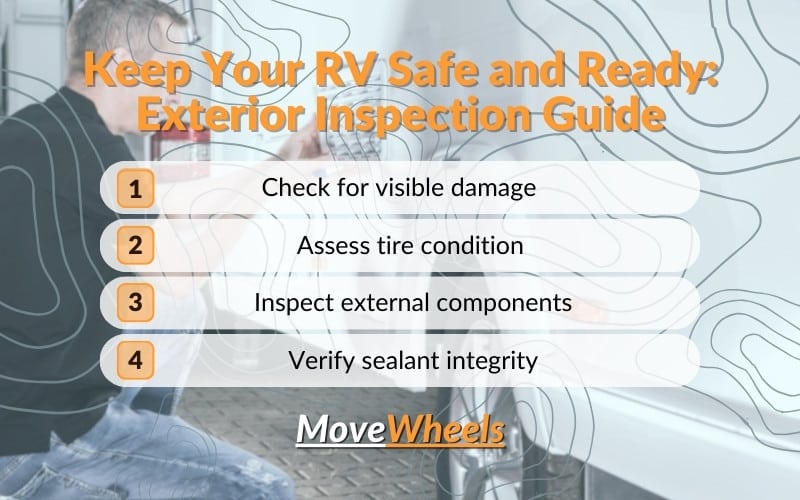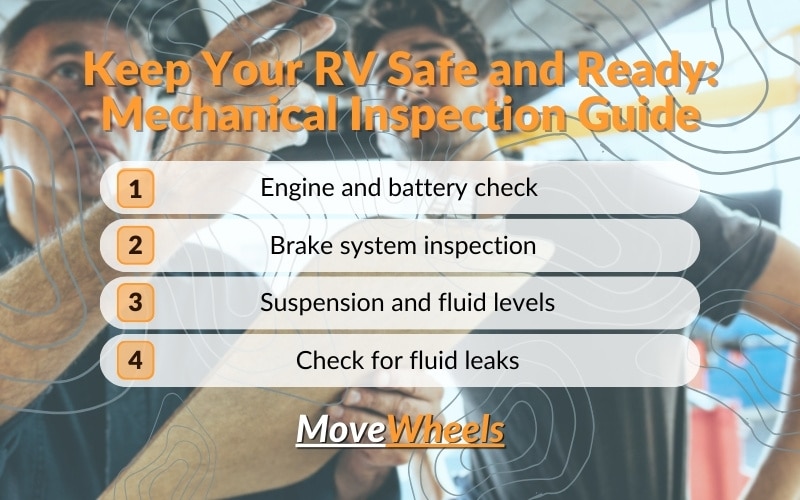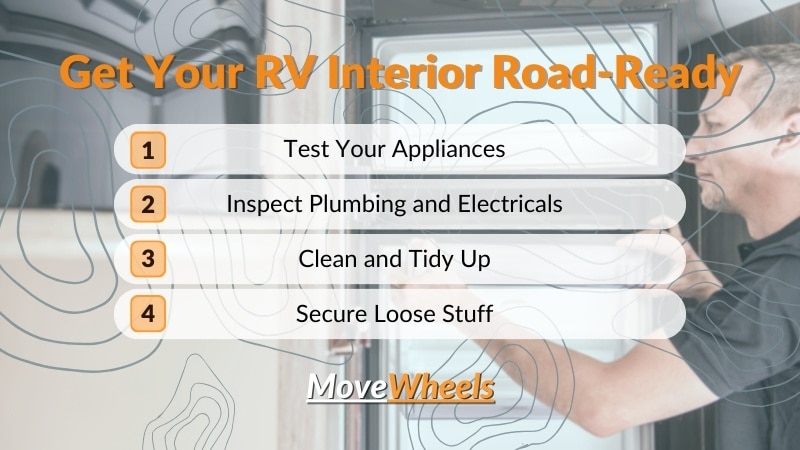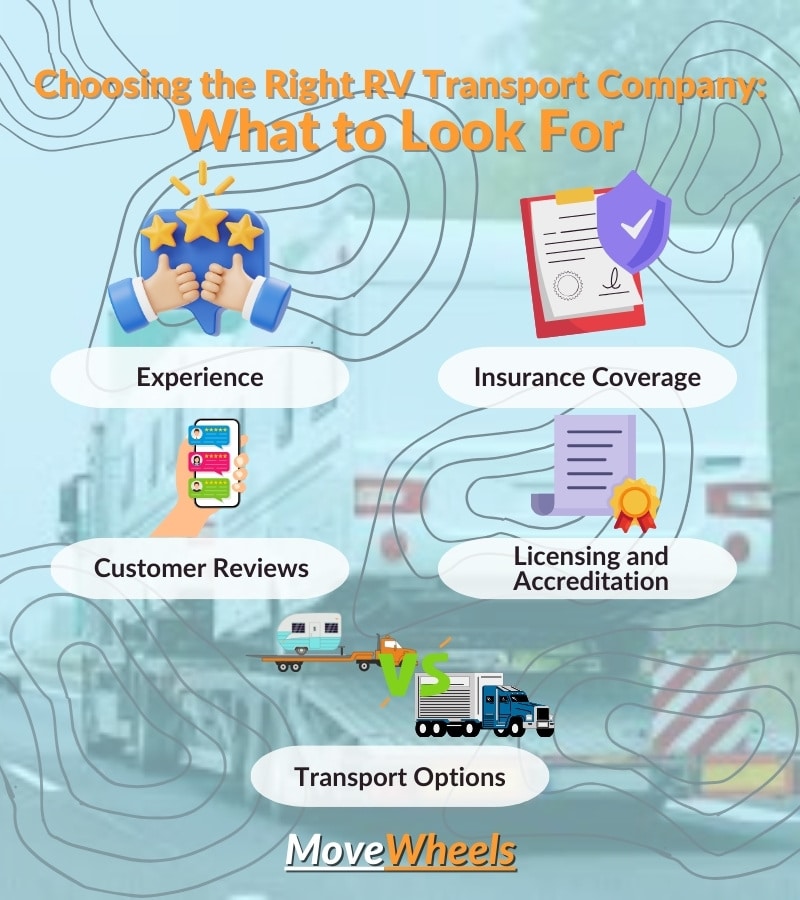As the freshness of spring fills the air, the call of the open road becomes irresistible to RV enthusiasts. But before you embark on your next adventure, it’s essential to ensure your RV readiness is on top to face the journeys ahead. The transition from winter storage to spring travel demands careful attention to every aspect of your RV’s condition.
At MoveWheels, we understand the importance of your trailer being ready and have crafted this comprehensive pre-transport checklist to guarantee a smooth and stress-free travel experience. From meticulous exterior inspections to ensuring the reliability of mechanical systems, each step is designed to optimize RV maintenance and transportation, ensuring your journey is as enjoyable as it is unforgettable.
Here’s a comprehensive pre-transport checklist to guide your RV prep and make sure your journeys are smooth and worry-free:
RV Readiness Checklist: Ensure Safe Travel
Inspecting the Exterior
Ensuring the exterior of your RV is in optimal condition is crucial for both RV readiness and safe RV shipping. Follow these steps to conduct a thorough inspection:

By following these steps to inspect the exterior of your RV, you can ensure that it is in optimal condition for spring travel and RV shipping. Addressing any issues proactively will not only enhance your RV readiness but also contribute to a safe and enjoyable journey.
Checking the Mechanical Systems
Ensuring the mechanical systems of your RV are in optimal condition is paramount for RV readiness and safe RV transportation. Here’s a step-by-step guide to inspecting these critical components:

By following these steps to check the mechanical systems of your RV, you can ensure that it is in optimal condition for spring travel and RV shipping. Addressing any issues proactively will not only enhance your RV readiness but also contribute to a safe and enjoyable journey.
Interior Preparation
Preparing the interior of your RV is essential for ensuring both comfort and safety during spring travel and RV shipping. Follow these steps to ready the interior of your RV for the road:

By following these steps to prepare the interior of your RV, you can ensure a comfortable and safe travel experience. Addressing any issues proactively will not only enhance your RV readiness but also contribute to a stress-free journey on the open road.
Preparing Documentation
Gathering and organizing necessary documentation is a crucial step in ensuring RV readiness and a smooth RV transportation process. Here’s what you need to prepare:

By preparing and organizing these documents in advance, you can streamline the RV transportation process and ensure that all necessary information is readily available when needed. This proactive approach to documentation management enhances RV readiness.
Choosing a Reliable Company for RV Transportation
Selecting a reputable RV transport company is crucial for ensuring the safe and timely delivery of your vehicle. Here are some factors to consider when making your decision:

By carefully evaluating these factors and selecting a reputable RV transport company like MoveWheels, you can enjoy peace of mind knowing that your vehicle is in capable hands. With a reliable transport partner, you can embark on your spring travels with confidence, knowing that your RV will arrive safely at its destination.
Preparing your RV for spring travel and transportation is a vital step in ensuring a seamless and enjoyable journey. By following the comprehensive pre-transport checklist outlined in this article, you can enhance your RV readiness and safeguard your vehicle for the road ahead. From inspecting the exterior and mechanical systems to preparing documentation and choosing a reliable transport company, each step plays a crucial role in ensuring a smooth travel experience.
Remember, thorough preparation is key to a stress-free journey, whether you’re embarking on a weekend getaway or a cross-country adventure. With MoveWheels as your trusted partner in RV transportation, you can rest assured that your vehicle will be handled with the utmost care and professionalism.
For more tips and insights on RV towing and transportation, be sure to check out MoveWheels’ blog.
Safe travels!
FAQ
What is the process for obtaining a quote for RV transportation services?
To receive a quote for RV transportation services, simply provide us with details about your RV, including its make, model, dimensions, and destination. Our team will assess your needs and provide you with a personalized quote tailored to your requirements.
How often should I perform maintenance checks on my RV before spring travel?
It’s recommended to conduct a thorough maintenance check on your RV at least once a month, especially before embarking on any long-distance trips. This helps ensure that your vehicle is in optimal condition for safe and reliable travel.
What are some common signs of wear and tear on RV tires, and how can I address them?
Common signs of tire wear include uneven tread wear, cracking, and bulging. To address these issues, regularly inspect your tires for signs of damage and ensure proper inflation. Consider rotating your tires and replacing them if necessary to maintain optimal performance and safety.
How can I protect my RV’s exterior from damage during transportation?
To protect your RV’s exterior during transportation, consider investing in a high-quality cover or protective film. Additionally, ensure that all external components are securely fastened and consider using protective padding or covers for vulnerable areas such as windows and mirrors.
Are there any specific maintenance tasks I should prioritize for RVs that have been in storage over the winter?
Yes, RVs that have been in storage over the winter may require additional maintenance tasks such as checking for rodent damage, inspecting seals and gaskets for signs of deterioration, and flushing out water systems to remove any antifreeze residue.
What steps should I take to winterize my RV before storing it for the season?
To winterize your RV, drain all water tanks and lines, add antifreeze to plumbing systems, and seal off any openings to prevent pests from entering. Additionally, consider using RV covers or tarps to protect your vehicle from snow and ice.
Similiar Articles
- How to Ship Multiple Cars at Once: Family Moves, Small Fleets, and Bulk Discounts
- How One of the Top RV Shipping Companies Stands Out
- Best Online Car Buying Platforms – The Ultimate Guide
- The Definitive 2025 Guide to the Cheapest Ways to Ship a Car
- Costco Auto Transport Made Easy – Ship Your Car Hassle‑Free with MoveWheels
- Is Your RV Ready for Spring Travel? Pre-Transport Checklist
- Open Vehicle Transport: How it Works and How Much It Costs in 2024
- Secure and Sophisticated: Your Complete Guide to Enclosed Auto Transport with MoveWheels
- New Year, New Motorcycle: Top Motorcycles` Choice among Americans in 2024
- How Vehicle Type Impacts Transportation Costs: From Cars to Heavy Equipment
